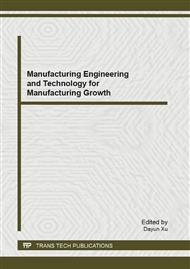[1]
K. Sebastian, S. Heyer , S. Chiotellis, G. Seliger, Process planning for IT-equipment remanufacturing. CIRP Journal of Manufacturing Science and Technology. 2 (2009) 13-20.
DOI: 10.1016/j.cirpj.2009.07.003
Google Scholar
[2]
Lyons and Burford The League of Women Voters. The Garbage Primer. New York, (1993).
Google Scholar
[3]
O.E. Simolowo, A. Mousavi, P.O. Adjapong, A Computer-Based Product Classification and Component Detection for Demanufacturing Processes International Journal of Computer Intergrated Manufacturing. 24 ( 2011) 10 900 – 914.
DOI: 10.1080/0951192x.2011.579169
Google Scholar
[4]
M. S. Abu Bakar, S. Rahimifard, Computer-aided recycling process planning for end-of-life electrical and electronic equipment, Proc. IMechE. 221 (2007) Part B: J. Engineering Manufacture.
DOI: 10.1243/09544054jem801sc
Google Scholar
[5]
P. Ranky, S.C. Velumani, A method, a tool (CORA) and application examples for analyzing disassembly user interface design criteria, International Journal of Computer Integrated Manufacturing. 16 (2003) 4–5 317–325.
DOI: 10.1080/0951192031000089200
Google Scholar
[6]
A. Fulvio, B. Giorgio, C. Maurizio, Eco-sustainable energy and environmental strategies in design for recycling: the software ENDLESS, Ecological Modelling. 163 (2003) 101–118.
DOI: 10.1016/s0304-3800(02)00418-0
Google Scholar
[7]
O. Tang, R.W. Grubbstrom, and S. Zanoni, Economic evaluation of disassembly processes in remanufacturing systems. Int. J. Prod. Res. 42 (2004 ) 17 3603–3617.
DOI: 10.1080/00207540410001699435
Google Scholar
[8]
S. A. Gerner, A. Kobeissi, B. David, Z. Binder, and B. Descotes-Genon, Integrated approach for disassembly processes generation and recycling evaluation of an end-of-life product. Int. J. Prod. Res., 43 (2005 ) 1 195–222.
DOI: 10.1080/00207540412331270414
Google Scholar
[9]
S. G. Lee, S. W. Lye, and M.K. Khoo, A multi-objective methodology for evaluating product end-of-life options and disassembly. Int. J. Advance Mfg Technol. 18 (2001) 148–156.
DOI: 10.1007/s001700170086
Google Scholar
[10]
E. Misimi, J. Mathiassen, U. Erikson, Computer vision-based sorting Of Atlantic Salmon (Salmo Salar) fillets According to their color level, Journal of Food Science. 72 (2007) 1 30-35.
DOI: 10.1111/j.1750-3841.2006.00241.x
Google Scholar
[11]
Matlab®, 2009. The Mathworks Inc., 1984–2009 (Image processingToolbox).
Google Scholar


